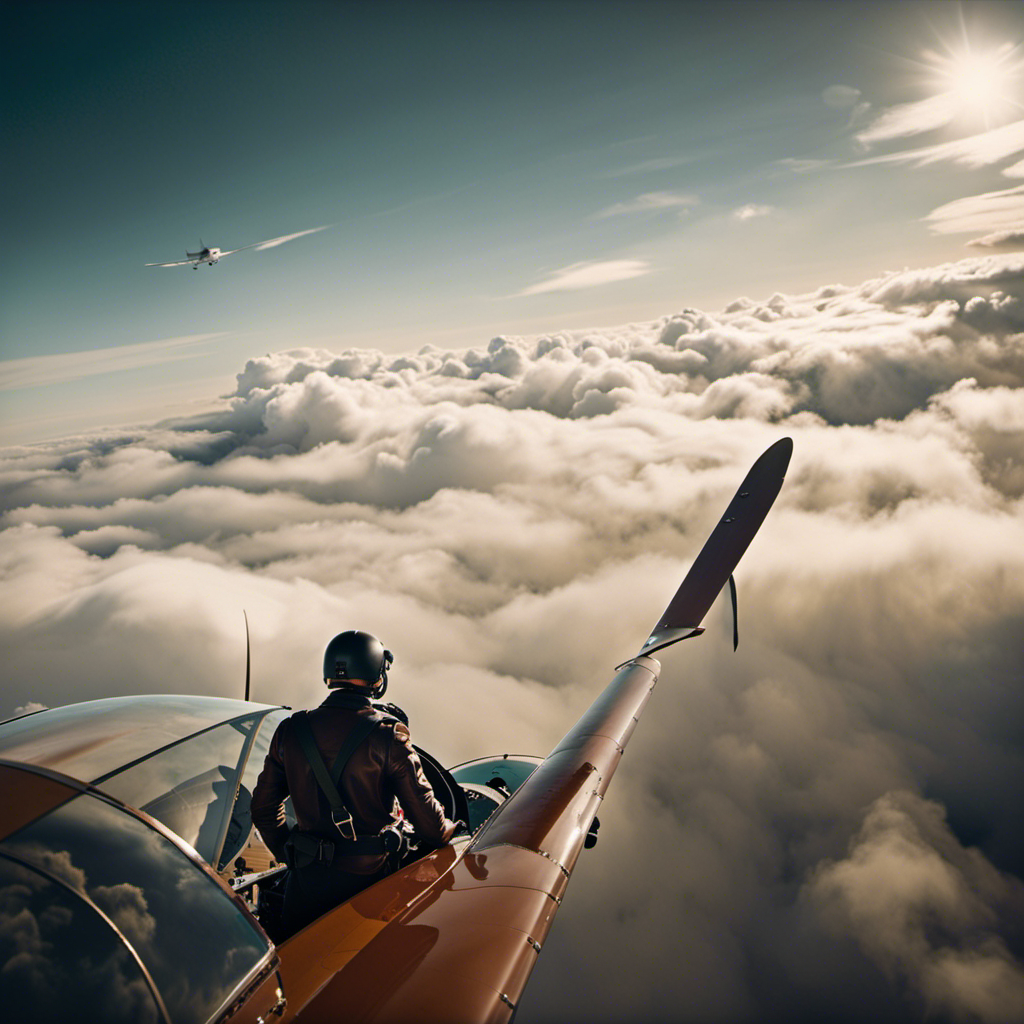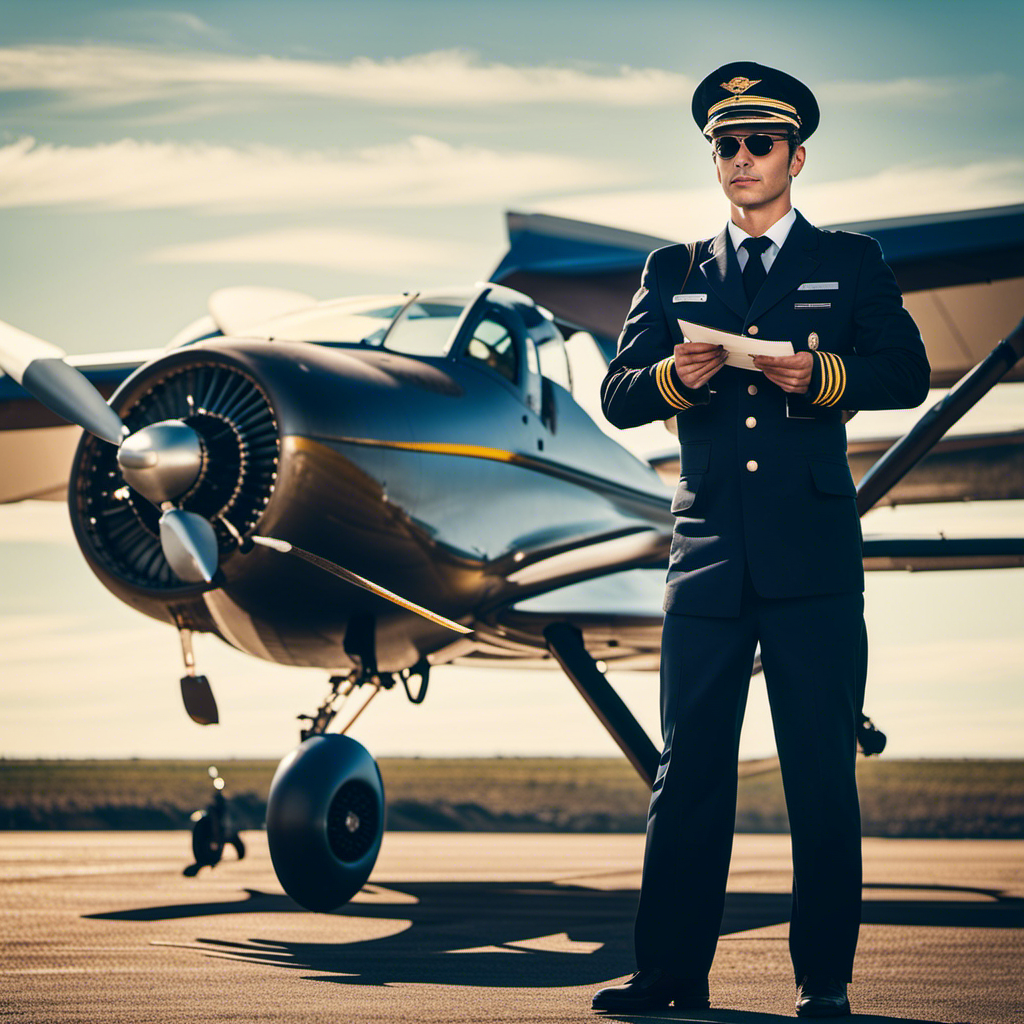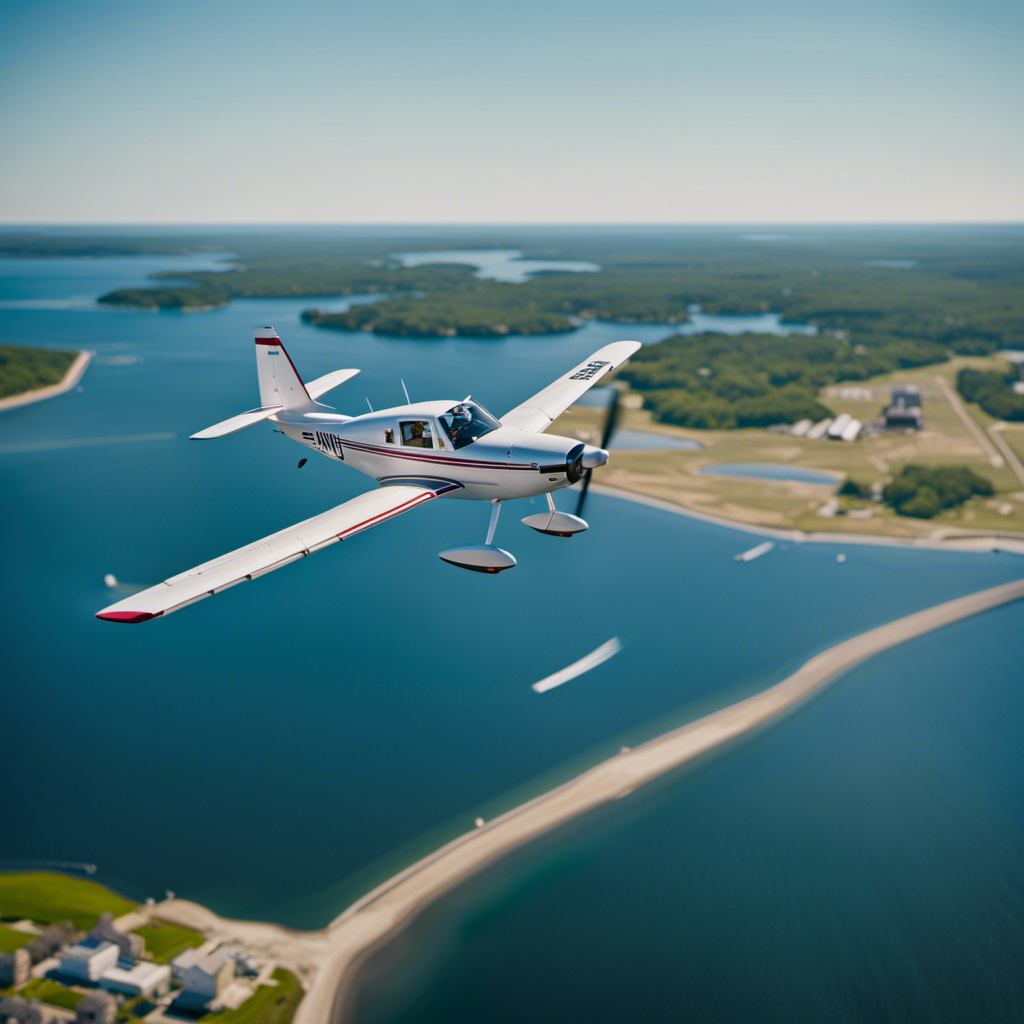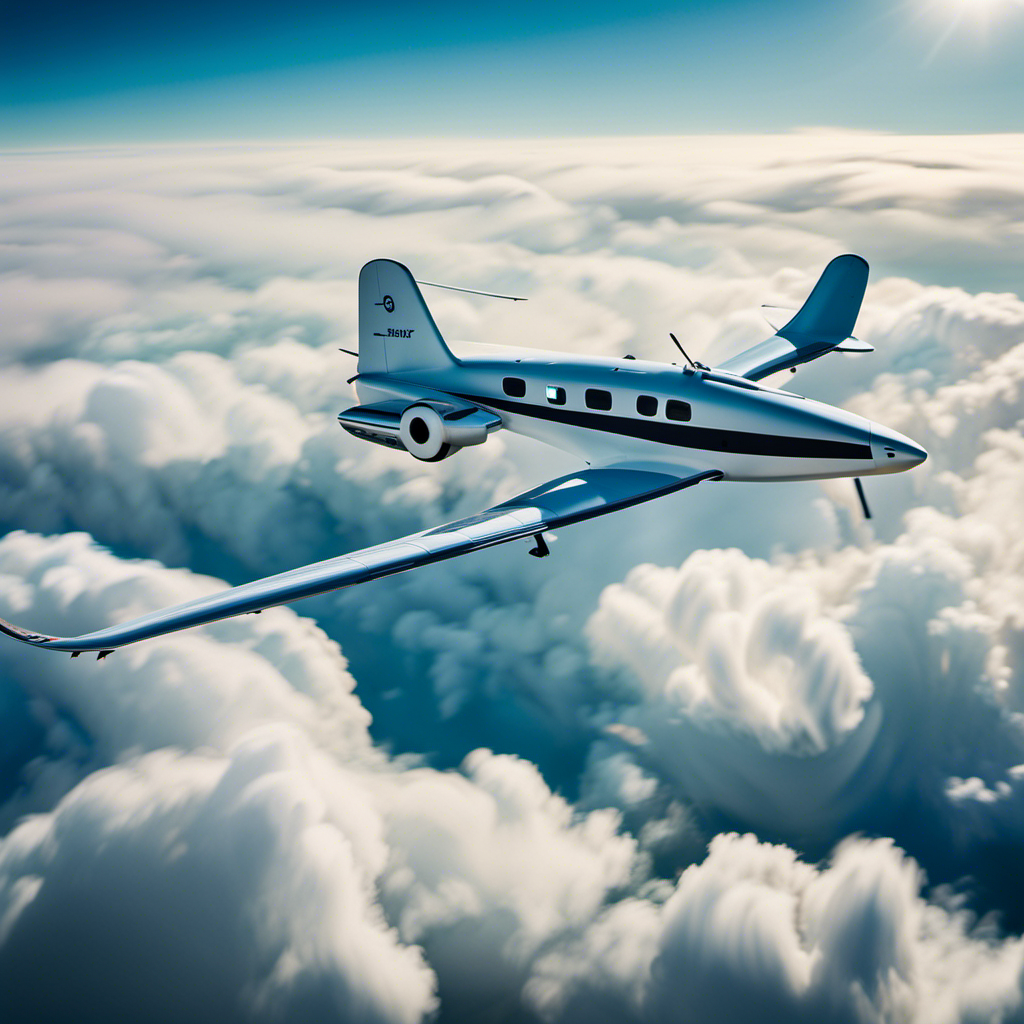I’ve always been captivated by the concept of gliding across the heavens, and now, I’m truly making that dream a reality.
In this article, I’ll take you on a journey as I learn to fly a single-engine plane. From understanding the basics of flight to mastering the controls, we’ll dive into the technical aspects of this thrilling endeavor.
We’ll explore the challenges of takeoff and landing, the intricacies of aviation charts and instruments, and the exhilaration of solo flights.
So buckle up and join me as we embark on this incredible adventure into the world of aviation.
Key Takeaways
- Overcoming fear of heights and gaining confidence
- Exploring different types of aircraft and flying conditions
- Building hours and experience through cross-country and night flights
- Achieving pilot’s license: Final steps and requirements
Understanding the Basics of Flight
You’ll need to grasp the basics of flight before you can confidently soar through the sky in a single-engine plane. Understanding aerodynamics principles is crucial to mastering flight.
Lift, generated by the wings, allows the plane to rise and stay airborne. Drag, on the other hand, is the force that opposes the motion of the plane, caused by air resistance.
Weather factors also play a significant role in flight performance. Wind speed and direction can affect the aircraft’s speed and stability, while atmospheric conditions such as temperature and humidity can impact engine performance.
By comprehending these fundamental principles and considering weather factors, you’ll be better equipped to navigate the skies safely.
Now, let’s transition into the next section about choosing the right flight school, a crucial step in your journey to becoming a pilot.
Choosing the Right Flight School
Before enrolling, it’s important to research and compare different flight schools to find the right one for you. When evaluating instructor qualifications, consider their experience level, certifications, and teaching style. A knowledgeable and experienced instructor can greatly impact your learning experience and ensure your safety.
Another crucial factor to consider is the cost and financing options available. Flight training can be a significant investment, so it’s essential to find a school that offers flexible payment plans or financial aid options.
Additionally, take into account the overall atmosphere and resources provided by the flight school. Look for a supportive and professional environment that will help you thrive as a student pilot.
Once you have chosen the right flight school, you can begin mastering the controls of a single-engine plane.
Mastering the Controls of a Single-Engine Plane
Once you’ve chosen the right flight school, it’s time to start getting comfortable with the controls of a single-engine aircraft. Perfecting aerial maneuvers and mastering aerobatics in a single-engine plane is an essential skill for any pilot. It requires precise control of the aircraft, understanding its limits, and maintaining situational awareness.
Advanced navigation techniques, such as utilizing GPS and electronic flight bags, are also crucial for safe and efficient flying. GPS technology allows for accurate positioning and navigation, while electronic flight bags provide pilots with digital charts, weather information, and other useful tools. Learning these techniques will enhance your ability to plan and execute flights with precision.
Now, let’s transition into the next section about learning takeoff and landing techniques, fundamental skills every pilot must master.
Learning Takeoff and Landing Techniques
To become a skilled pilot, it’s important to familiarize yourself with the techniques for takeoff and landing.
Communication plays a crucial role during these critical phases of flight. Before taking off, it’s vital to communicate with the control tower to ensure a safe departure.
During landing, clear and concise communication between the pilot and air traffic control is essential for a smooth touchdown.
Additionally, avoiding common mistakes is crucial to ensure a successful takeoff and landing. These mistakes include improper runway alignment, incorrect airspeed control, and poor judgment of weather conditions.
By understanding the importance of communication and being aware of common mistakes, pilots can enhance their skills and ensure safe takeoffs and landings.
Now, let’s transition into the subsequent section about navigating the skies: understanding aviation charts and instruments.
Navigating the Skies: Understanding Aviation Charts and Instruments
Now that you have mastered takeoff and landing techniques, it’s time to delve into the intricacies of navigating the skies by understanding aviation charts and instruments. As a pilot, it is crucial to have a comprehensive understanding of airspace classifications and how to interpret weather conditions for safe flying. Aviation charts and instruments provide valuable information that allows us to plan our routes, avoid restricted areas, and make informed decisions while in the air. To illustrate this, here is a table summarizing the different airspace classifications and their corresponding characteristics:
| Airspace Classification | Description |
|---|---|
| Class A | Controlled airspace for high-altitude IFR flights |
| Class B | Controlled airspace for busy airports |
| Class C | Controlled airspace for airports with moderate traffic |
| Class D | Controlled airspace for airports with low traffic |
Practicing Emergency Procedures and Safety Measures
As pilots, we must be prepared to handle emergencies and prioritize safety. This involves practicing emergency procedures and safety measures. Here are four essential practices to ensure our readiness for any unforeseen situation in the air:
-
Practicing emergency landings: We simulate engine failures and practice executing emergency landings in a controlled environment. This helps us develop the muscle memory and decision-making skills necessary to handle such scenarios with confidence.
-
Reviewing safety precautions during turbulence: Turbulence can be unnerving, but following safety protocols such as tightening seatbelts, securing loose items, and maintaining control of the aircraft can help mitigate risks and ensure the safety of everyone on board.
-
Conducting regular emergency drills: By regularly rehearsing emergency procedures, we enhance our ability to respond quickly and efficiently in critical situations. This includes actions such as handling engine fires, cabin depressurization, and emergency evacuations.
-
Staying current on emergency protocols and regulations: It is crucial to stay up-to-date with the latest emergency procedures and regulations set by aviation authorities. This ensures our knowledge remains current and enables us to adapt to any changes in emergency protocols.
Gaining Confidence through Solo Flights
Gaining confidence through flying alone can be a transformative experience for pilots. It is a culmination of all the training and preparation that has led up to this moment.
As a pilot, I have spent countless hours honing my skills in flight simulators, which have provided a safe environment to practice various scenarios and build confidence. However, nothing compares to the feeling of overcoming my fear of heights through solo flights.
The first time I took off on my own, the rush of adrenaline mixed with a sense of accomplishment was indescribable. It was as if all the doubts and anxieties melted away, replaced by a newfound belief in my abilities.
With this renewed confidence, I am now ready to explore different types of aircraft and flying conditions, further expanding my knowledge and skillset.
Exploring Different Types of Aircraft and Flying Conditions
Exploring various aircraft and flying conditions can broaden a pilot’s knowledge and skillset. As I continue my journey in learning to fly a single-engine plane, I am eager to expand my horizons and tackle more challenging situations.
Flying in adverse weather conditions is one aspect that I am excited to explore. It requires a deep understanding of meteorology and the ability to make quick decisions under pressure. From thunderstorms to gusty winds, these conditions demand a high level of skill and precision.
Additionally, I am eager to delve into advanced maneuvers. This includes aerobatic maneuvers such as loops, rolls, and spins, which require a thorough understanding of the aircraft’s capabilities and the ability to maintain control in extreme situations.
As I gain confidence in these areas, I am ready to move on to the next phase of building hours and experience: cross-country and night flights, where I can further enhance my skills and become a well-rounded pilot.
Building Hours and Experience: Cross-Country and Night Flights
When you tackle cross-country and night flights, you’ll gain valuable experience and further enhance your skills as a pilot. These types of flights present unique challenges that will help you become a well-rounded aviator.
Here are some key benefits of building flight hours through cross-country and night flights:
-
Enhances navigation skills: Navigating across long distances requires precise planning and execution, improving your ability to read charts, use GPS systems, and interpret weather information.
-
Improves decision-making: Flying at night or over unfamiliar terrain demands quick thinking and decisive action. It hones your ability to make sound judgments in high-pressure situations.
-
Enhances situational awareness: Cross-country flights expose you to a variety of airspace types, weather conditions, and air traffic, sharpening your ability to analyze and adapt to changing situations.
-
Increases confidence: Successfully completing cross-country and night flights builds confidence in your skills, preparing you for more challenging aviation endeavors.
Achieving Your Pilot’s License: The Final Steps and Requirements
Once you have completed the necessary flight hours and met the requirements, you’ll be ready to apply for your pilot’s license. It’s an exciting and rewarding milestone in your journey to becoming a pilot. However, before you can take that step, there are a few final steps and requirements to fulfill. One of the most important aspects is maintaining a logbook to record your flight hours and experiences. This logbook serves as a documentation of your progress and is essential for future reference. It not only shows your dedication and commitment but also provides valuable insights into your training and skill development. Overcoming challenges and setbacks is another crucial aspect of the pilot’s license journey. It is inevitable that you will face obstacles along the way, but it’s important to remain resilient and determined. Remember, every setback is an opportunity for growth and learning. Stay focused, stay motivated, and keep pushing forward.
| Importance of Maintaining a Logbook | Overcoming Challenges and Setbacks |
|---|---|
| Records flight hours and experiences | Builds resilience and determination |
| Provides valuable insights | Encourages growth and learning |
| Documents progress and development | Fosters motivation and focus |
| Demonstrates dedication and commitment | Strengthens skills and abilities |
Frequently Asked Questions
What is the average cost of flight training for a single-engine plane?
The average cost of flight training for a single-engine plane varies depending on factors such as location and the type of training program. However, it typically ranges from $8,000 to $15,000.
Are there any age restrictions for learning to fly a single-engine plane?
Age restrictions for learning to fly a single-engine plane vary by country. Safety guidelines are in place to ensure that pilots are physically and mentally fit. It is important to consult local aviation authorities for specific requirements.
How long does it typically take to earn a pilot’s license for a single-engine plane?
It typically takes about 6 to 12 months to earn a pilot’s license for a single-engine plane. The flight training duration can vary depending on the individual’s availability and progress. The pilot’s license cost can range from $8,000 to $15,000.
What are the common challenges faced by student pilots during solo flights?
Challenges faced by student pilots during solo flights include managing navigation, weather conditions, and communication. Safety precautions such as pre-flight checks, maintaining situational awareness, and adhering to air traffic control instructions are crucial to ensure a successful and safe flight.
Are there any physical fitness requirements for learning to fly a single-engine plane?
To learn to fly a single-engine plane, physical fitness requirements are essential. According to FAA, pilots must possess a third-class medical certificate, ensuring they meet the minimum health standards for safe flying.
Conclusion
After embarking on the journey of learning to fly a single-engine plane, I have gained a deep understanding of the intricacies of flight. From mastering the controls to navigating the skies with confidence, each step has been a thrilling adventure.
As I soared through the clouds, I witnessed the beauty of the world from a perspective few get to experience. It’s like painting a masterpiece in the sky, where every stroke of the controls creates a masterpiece of flight.
Now, as I approach the final steps towards achieving my pilot’s license, I can’t help but feel a sense of accomplishment and excitement for what lies ahead.
With a heart that soars as high as the skies, Aria, affectionately known as “Skylark,” is the driving force behind Soaring Skyways. Her journey into the gliding world began as a young dreamer gazing up at the soaring birds, yearning to experience the weightlessness and freedom they embodied. With years of experience both in the cockpit and behind the scenes, Aria’s commitment to the gliding community is unwavering.









